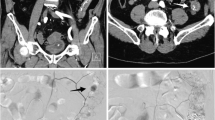Abstract
Purpose
The purpose of this study was to assess safety, efficacy, and clinical outcomes following transcatheter arterial embolization (TAE) of acute gastrointestinal (GI) bleeding.
Materials and Methods
Ninety-five patients (male:female ratio = 53:42, mean age 62 years) that underwent 95 TAEs for GI hemorrhage between 2002 and 2010 were retrospectively studied. Seventy-six of 95 (80 %) patients had upper GI bleeds and 19/95 (20 %) patients had lower GI bleeds. A mean of 7 (range 0–27) packed red blood cell units were transfused pre-procedure, and 90/95 (95 %) procedures were urgent or emergent. Twenty-seven of 95 (28 %) patients were hemodynamically unstable. Measured outcomes included procedure technical success, adverse events, and 30-day rebleeding and mortality rates.
Results
Bleeding etiology included peptic ulcer disease (45/95, 47 %), cancer (14/95, 15 %), diverticulosis (13/95, 14 %), and other (23/95, 24 %). Vessels embolized (n = 109) included gastroduodenal (42/109, 39 %), pancreaticoduodenal (22/109, 20 %), gastric (21/109, 19 %), superior mesenteric (12/109, 11 %), inferior mesenteric (8/109, 7 %), and splenic (4/109, 4 %) artery branches. Technical success with immediate hemostasis was achieved in 93/95 (98 %) cases. Most common embolic agents included coils (66/109, 61 %) and/or gelatin sponge (19/109, 17 %). Targeted versus empiric embolization were performed in 57/95 (60 %) and 38/95 (40 %) cases, respectively. Complications included bowel ischemia (4/95, 4 %) and coil migration in 3/95 (3 %). 30-day rebleeding rate was 23 % (22/95). Overall 30-day mortality rate was 18 % (16/89). Empiric embolization resulted in similar rebleeding (23 vs 24 %) but higher mortality (31 vs 9 %) rates compared to embolization for active extravasation.
Conclusions
TAE controlled GI bleeding with high technical success, safety, and efficacy, and should be considered when endoscopic therapy is not feasible or unsuccessful.

Similar content being viewed by others
References
Adler DG, Leighton JA, Davila RE, et al. ASGE guideline: the role of endoscopy in acute non-variceal upper-GI hemorrhage. Gastrointest Endosc. 2004;60:497–504.
Davila RE, Rajan E, Adler DG, et al. ASGE guideline: the role of endoscopy in the patient with lower-GI bleeding. Gastrointest Endosc. 2005;62:656–660.
Yavorski RT, Wong RK, Maydonovitch C, Battin LS, Furnia A, Amundson DE. Analysis of 3,294 cases of upper gastrointestinal bleeding in military medical facilities. Am J Gastroenterol. 1995;90:568–573.
Rockall TA, Logan RF, Devlin HB, Northfield TC. Incidence of and mortality from acute upper gastrointestinal haemorrhage in the United Kingdom. Steering committee and members of the national audit of acute upper gastrointestinal haemorrhage. BMJ. 1995;311:222–226.
Strate LL, Ayanian JZ, Kotler G, Syngal S. Risk factors for mortality in lower intestinal bleeding. Clin Gastroenterol Hepatol. 2008;6:1004–1010 (quiz 1955).
Darcy M. Treatment of lower gastrointestinal bleeding: vasopressin infusion versus embolization. J Vasc Interv Radiol. 2003;14:535–543.
Weldon DT, Burke SJ, Sun S, Mimura H, Golzarian J. Interventional management of lower gastrointestinal bleeding. Eur Radiol. 2008;18:857–867.
Mirsadraee S, Tirukonda P, Nicholson A, Everett SM, McPherson SJ. Embolization for non-variceal upper gastrointestinal tract haemorrhage: a systematic review. Clin Radiol. 2011;66:500–509.
Angle JF, Siddiqi NH, Wallace MJ, et al. Quality improvement guidelines for percutaneous transcatheter embolization: society of interventional radiology standards of practice committee. J Vasc Interv Radiol. 2010;21:1479–1486.
Brown DB, Cardella JF, Sacks D, et al. Quality improvement guidelines for transhepatic arterial chemoembolization, embolization, and chemotherapeutic infusion for hepatic malignancy. J Vasc Interv Radiol. 2006;17:225–232.
Baum S, Nusbaum M, Blakemore WS, Finkelstein AK. The preoperative radiographic demonstration of intra-abdominal bleeding from undetermined sites by percutaneous selective celiac and superior mesenteric arteriography. Surgery. 1965;58:797–805.
Baum S, Nusbaum M. The control of gastrointestinal hemorrhage by selective mesenteric arterial infusion of vasopressin. Radiology. 1971;98:497–505.
Funaki B. Endovascular intervention for the treatment of acute arterial gastrointestinal hemorrhage. Gastroenterol Clin North Am. 2002;31:701–713.
Bookstein JJ, Chlosta EM, Foley D, Walter JF. Transcatheter hemostasis of gastrointestinal bleeding using modified autogenous clot. Radiology. 1974;113:277–285.
Goldberger LE, Bookstein JJ. Transcatheter embolization for treatment of diverticular hemorrhage. Radiology. 1977;122:613–617.
Rosch J, Dotter CT, Brown MJ. Selective arterial embolization. A new method for control of acute gastrointestinal bleeding. Radiology. 1972;102:303–306.
Miller M Jr, Smith TP. Angiographic diagnosis and endovascular management of nonvariceal gastrointestinal hemorrhage. Gastroenterol Clin North Am. 2005;34:735–752.
Loffroy R, Rao P, Ota S, De Lin M, Kwak BK, Geschwind JF. Embolization of acute nonvariceal upper gastrointestinal hemorrhage resistant to endoscopic treatment: results and predictors of recurrent bleeding. Cardiovasc Intervent Radiol. 2010;33:1088–1100.
Wong TC, Wong KT, Chiu PW, et al. A comparison of angiographic embolization with surgery after failed endoscopic hemostasis to bleeding peptic ulcers. Gastrointest Endosc. 2011;73:900–908.
Aina R, Oliva VL, Therasse E, et al. Arterial embolotherapy for upper gastrointestinal hemorrhage: outcome assessment. J Vasc Interv Radiol. 2001;12:195–200.
Schenker MP, Duszak R Jr, Soulen MC, et al. Upper gastrointestinal hemorrhage and transcatheter embolotherapy: clinical and technical factors impacting success and survival. J Vasc Interv Radiol. 2001;12:1263–1271.
Loffroy R, Guiu B, D’Athis P, et al. Arterial embolotherapy for endoscopically unmanageable acute gastroduodenal hemorrhage: predictors of early rebleeding. Clin Gastroenterol Hepatol. 2009;7:515–523.
Arrayeh E, Fidelman N, Gordon RL, et al. Transcatheter arterial embolization for upper gastrointestinal nonvariceal hemorrhage: is empiric embolization warranted? Cardiovasc Intervent Radiol. 2012;35:1346–1354.
Padia SA, Geisinger MA, Newman JS, Pierce G, Obuchowski NA, Sands MJ. Effectiveness of coil embolization in angiographically detectable versus non-detectable sources of upper gastrointestinal hemorrhage. J Vasc Interv Radiol. 2009;20:461–466.
Chang WC, Liu CH, Hsu HH, et al. Intra-arterial treatment in patients with acute massive gastrointestinal bleeding after endoscopic failure: comparisons between positive versus negative contrast extravasation groups. Korean J Radiol. 2011;12:568–578.
Ichiro I, Shushi H, Akihiko I, Yasuhiko I, Yasuyuki Y. Empiric transcatheter arterial embolization for massive bleeding from duodenal ulcers: efficacy and complications. J Vasc Interv Radiol. 2011;22:911–916.
Conflict of interest
None.
Author information
Authors and Affiliations
Corresponding author
Rights and permissions
About this article
Cite this article
Yap, F.Y., Omene, B.O., Patel, M.N. et al. Transcatheter Embolotherapy for Gastrointestinal Bleeding: A Single Center Review of Safety, Efficacy, and Clinical Outcomes. Dig Dis Sci 58, 1976–1984 (2013). https://doi.org/10.1007/s10620-012-2547-z
Received:
Accepted:
Published:
Issue Date:
DOI: https://doi.org/10.1007/s10620-012-2547-z




